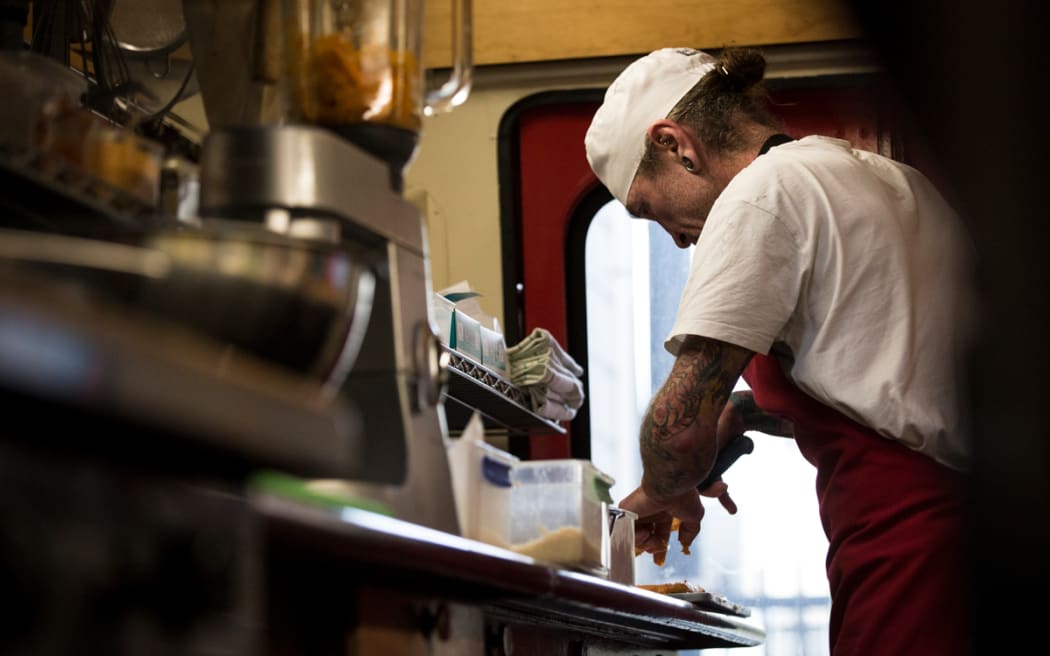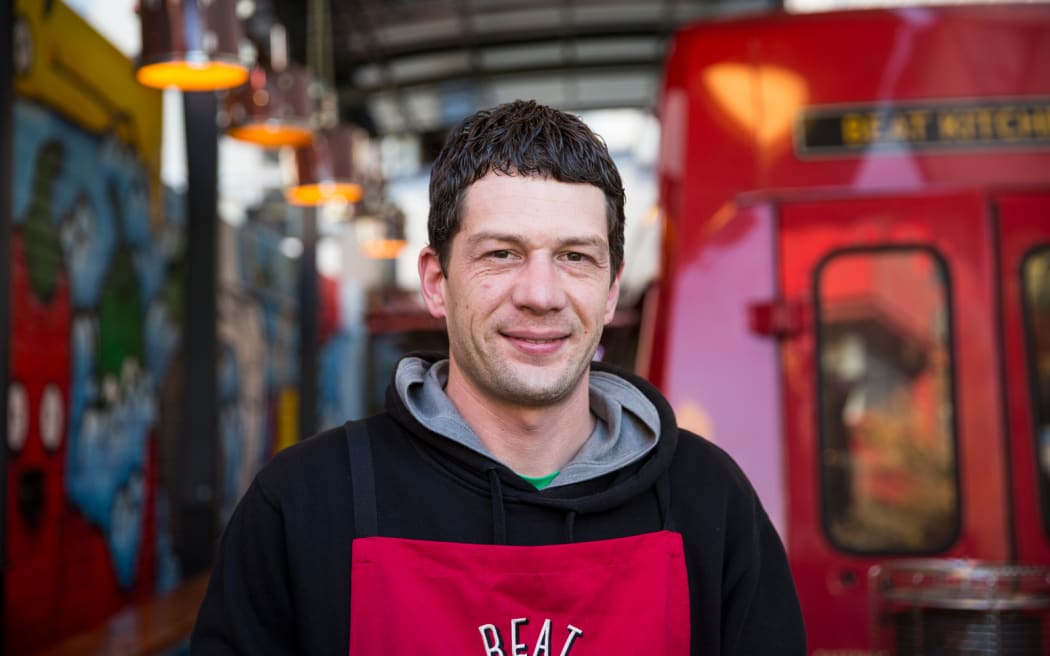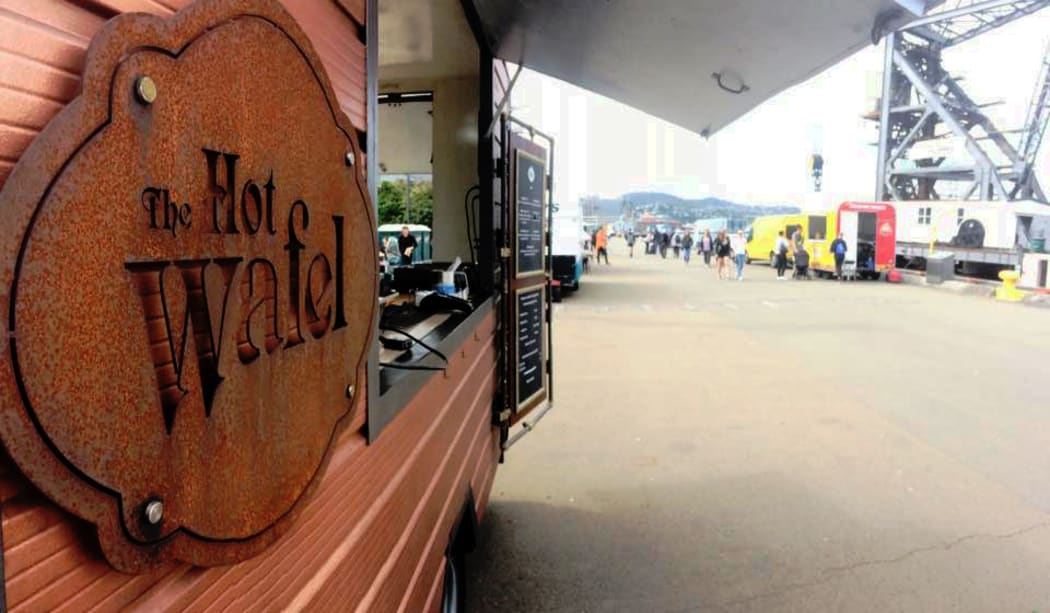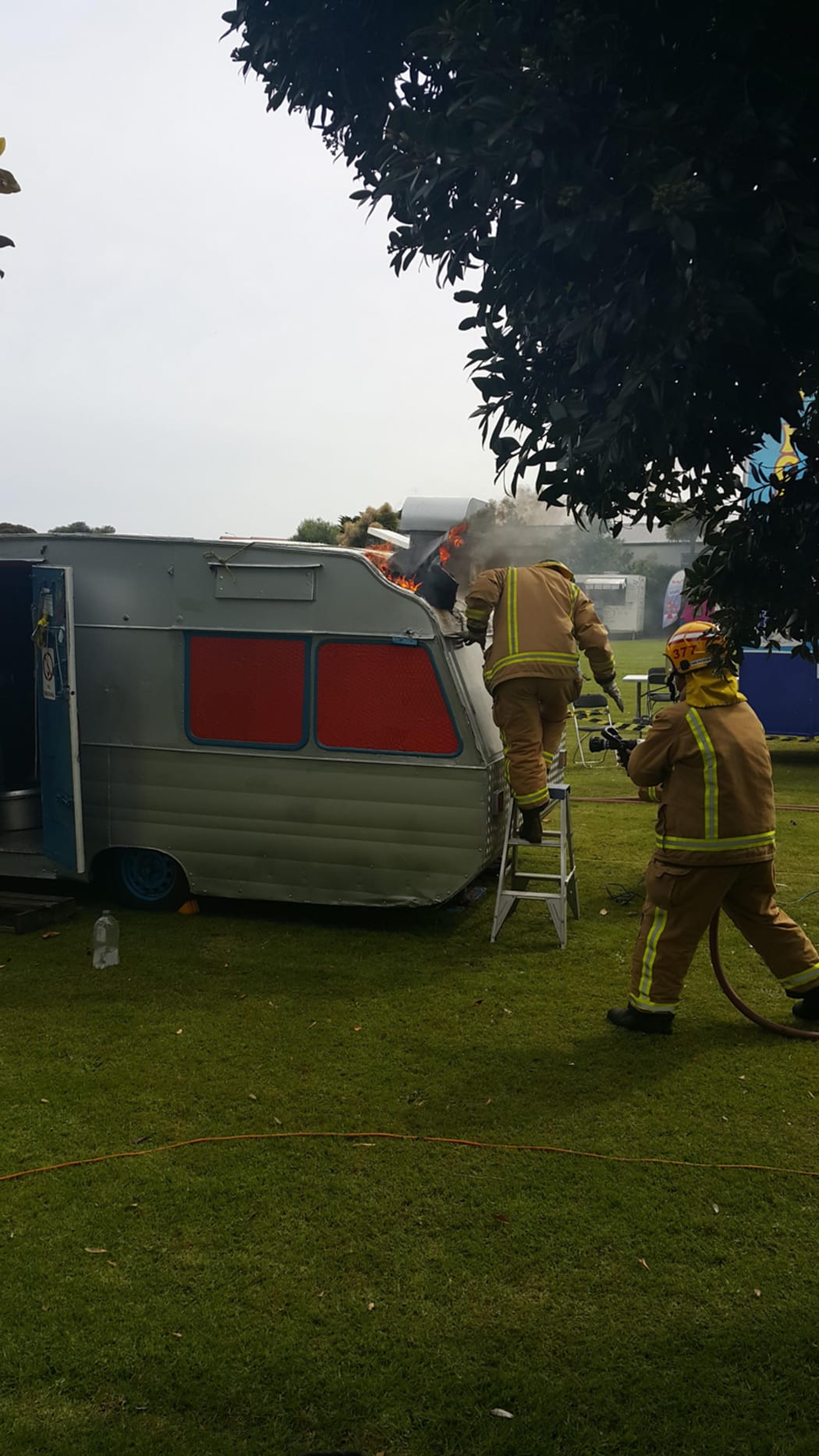Three chefs driven to fuel the masses.

Shane Lunn at work in the Beat Kitchen food truck. Photo: Rebekah Parsons-King
THE RIDE
Before Beat Kitchen, the bus was a motorhome. And before it was a motorhome, it was a library on wheels.
The bus had belonged to a large public library in Tokyo, where it made book runs all over the city, its interior lined with shelves. It had been decommissioned for 20 years by the time it was brought to New Zealand.
A Dunedin couple had imported the vehicle and almost finished converting it into a motorhome when they decided to move to Australia.
Craig Sefton found the bus three years when he was trawling Trade Me in the early hours of the morning. He called Kei Akiyama, who he’d spent six months working with in Christchurch cafe.
“I called and said ‘Hey, I’m thinking about putting a kitchen in this bus, how stupid is that?’ And she was like ‘Yeah, that’s pretty stupid. Let’s do it.’”
Craig had been toying with the idea of running a food truck for a while, but it was this old Toyota Coaster which revved him into action.
“I nearly had a fire engine, ambulance, an old sixties ex-army vehicle,” he says. “If I didn’t see that bus I’d probably still have my old job.”

Beat Kitchen co-owner Craig Sefton. Photo: RNZ/Rebekah Parsons-King
Beat Kitchen’s food is based on cuisine from around the globe, inspired by each owner’s travel experiences. Craig cooked modern Greek food in Melbourne, luxury fare at a chalet in the French Alps and learned the art of confit in south-western France. He also travelled across Thailand and Malaysia eating street food.
Kei is inspired by South American street food, and the South American fusion food of the Japanese and Chinese communities in Peru. She’s worked as a chef in NZ and Japan, in luxury lodges and cafes.
Craig and Kei had both been chefs for about 15 years before they served their first customers on New Year’s Day 2016, a year after they bought the bus.
Adapting the former library and motorhome into a mobile commercial kitchen took some time, as did having the roof “literally tin-canned” to raise it two feet to accommodate Craig’s six-foot-five frame.
Craig is pleased to be in the food bus business, even though there have been some steep learning curves.
“We thought it was going to be quite simple but it is quite different, it really is. Things like chopping herbs in the wind with all the doors open or going around a corner a little too fast and having to do an hour’s clean up afterwards,” he says.
“It’s been a helluva ride.”
THE RECIPE

Hot Wafel parked at the Wellington waterfront last summer. Photo: Hot Wafel/Facebook
A Belgian recipe that made its unlikely way to New Zealand is the secret of The Hot Wafel’s success. That, and the tenacity of owner Rick Unuia.
Rick saw a gap in the market for a dessert truck, but can’t really remember how he decided on waffles. What he does remember is that after the decision was made, he spent three years trying to find the perfect recipe.
Using only a small electric waffle maker to trial recipe after recipe, Rick began his quest for the ultimate waffle in 2010. After many months he had a waffle he was satisfied with. But that wasn’t the end of his search.
Rick heard of a waffle different to the Brussels-style of waffle he had created, one that was made with a yeast-filled dough instead of a batter.
He began a new search, this time for the perfect liege waffle.
Unlike the light and crispy Brussels waffle, the liege is more like a brioche or a doughnut and is made with pearl sugar, a type of rock sugar which melts on the outside of the waffle but remains crunchy on the inside.
“I got hold of a very popular food truck owner in New York City and hassled him for help.”
Thomas DeGeest of Wafels & Dinges put Rick in touch with another food truck owner closer to home: Nol Remacle of the now closed Wafel 4 U from Tauranga.
“He just gave me a story of how his grandfather was a baker in World War II,” Rick says. “He used to go after curfew on his little bike to deliver food.”
The Nazis ended up bombing the Stavelot bakery after seeing the lights on late at night, but the waffle recipe survived and was passed through the family to Nol, and eventually to Rick.
Rick had finally found a recipe for the perfect liege waffle. It’s the only type of waffle he’ll eat himself now, though he also serves the Brussels waffles.
The Hot Wafel serves both types of waffle with a range of extravagant toppings, including fruit, cream and sauces.
“It’s quite a fun food to kind of play with,” says Rick, who has now opened a second food business, a kiosk called Soul Shack, that makes American style soul food.

Sweet waffle, happy customer. Photo: Hot Wafel/Facebook
He feels lucky to have had such willing and generous guidance from experts in the waffle world.
“As far as I’m concerned, this success is due to them as well.”
THE TRAVELLING CHEF
Food and freedom, that’s what life about for Dean Moriarty, owner of High Roller.
Dean, who has been a chef since the age of 16, spent five years cooking on ferries. As well as his usual Wellington-Picton route, he also sailed with the Lynx ferry when it returned to England at the end of the high-season in New Zealand.
He cooked for the onboard restaurants and for the crew, but his favourite place was the takeaway bar. “It was quick, they’d just get their food and go. I think people are happy when it’s like that.”
Dean then spent five years as a chef for a theatre company which travelled across New Zealand, unpacking and repacking his portable kitchen at every stop, meeting new people to share the kitchen with and never knowing what facilities would be on hand at each location.
“We used to travel around, you’d be working all different hours, things were unpredictable. You didn’t know what you were in for, you just had to adapt,” he says.
I kind of enjoyed moving, I think that’s how it came about. Cooking while you move.
Dean decided he wanted to begin his own food business instead of working for someone else. He bought a 1978 Anglo Capri after searching for a food truck for six months. It had been parked on the previous owner’s lawn for 15 years.
Dean began updating the truck, with little to no knowledge of building and mostly on his own.
“I sort of refitted it. Even though it still looks rough, it’s tidy.”
He began his mobile seafood business soon after, at the last La De Da festival held in 2013.
Having a business involving vehicles and kitchens can mean twice the amount of problems. Dean had to deal with mechanical issues such as breakdowns and restaurant issues such as fire.
“I was at the Kapiti strawberry festival, I was just opening up. Nine o’clock, got up there, fire was on, oven hot, everything was ready, two fryers on full, chips were cooking. My mate was outside and saw smoke coming out of the roof.”

Fire fighters rush to the High Roller food caravan after it caught fire at the Kapiti strawberry festival. Photo: Supplied
The fire was caused by heat becoming trapped in the space between the air vent and roof.
“I didn’t know, I couldn’t see the fire. I could just see the smoke coming through the cracks.”
Firefighters put out the flames while a nearby band sang a song about fire, a fact that Dean is now able to laugh about a few years later.
He used some scrap metal to fix the van and used it as an opportunity to reinforce and change the style of the roof. He also made a little hatch in the roof which he is able to open in case the space overheats again.
“I haven’t had to use it again but I know it’s there. All these mishaps make you aware of what could happen,” Dean says.
“It was good as it was all just learning.”
Although he loves the flexibility of being able to move his food business at any time, Dean, like many food truck owners, is still searching for the perfect full-time spot.
“It hasn’t been easy, I’ll tell you that. Finding a place to settle and establish a clientele,” he says. “Councils and permits can be tough.”
Craig agrees, which is why he feels lucky Beat Kitchen found its full-time spot in Te Aro earlier this year.
“Everyone wants their own full-time spot for a food truck. It’s like the holy grail pretty much. It’s almost a full time job on the laptop getting places to park.”
Although Dean is still looking for a place to park up, he’s definitely learnt a lot since he began his food truck journey.
“When I first started I didn’t even know how to use a drill. I can cook now AND drill a hole.”
Having found freedom in working for himself, Dean is sure about one thing: he never wants to chef under anyone else again.
*Look out for Beat Kitchen, the Hot Wafel and High Roller at the Wellington On A Plate Food Truck Rally.


